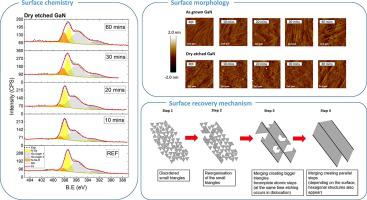Applied Surface Science ( IF 6.7 ) Pub Date : 2021-12-25 , DOI: 10.1016/j.apsusc.2021.152309 Sabria Benrabah 1, 2, 3 , Maxime Legallais 2 , Pascal Besson 4 , Simon Ruel 1 , Laura Vauche 1 , Bernard Pelissier 2 , Chloé Thieuleux 3 , Bassem Salem 2 , Matthew Charles 1

|
The impact of several wet etchants commonly encountered in the microelectronic industry on the surface chemistry of GaN on silicon was explored. In order to get closer to fully recessed gate HEMT fabrication processes, we investigated different kinds of GaN surfaces. This study was conducted on as-grown GaN and dry etched GaN, with etching consisting of inductive coupled plasma reactive ion etching (ICP-RIE), followed by atomic layer etching (ALE) and O2 plasma stripping. The impact of each wet treatment was evaluated by parallel Angle Resolved X-ray Photoelectron Spectroscopy (pAR-XPS). Treatment with phosphoric acid (H3PO4) showed a significant modification of the surface and further studies were performed using this treatment. The impact of H3PO4 on GaN surface chemistry and morphology was assessed by pAR-XPS and atomic force microscopy (AFM) respectively. A delayed effect was observed for dry etched samples compared to as-grown samples, with a successful recovery of the surface after 60 min of treatment. We also proposed a mechanism explaining the progressive formation on steps on the surface over time. Further research was performed on dry etched samples without ALE which also modified the delay time of the H3PO4 treatment, but still enabled a recovery of the surface morphology. In contrast to other studies, we showed that, with the appropriate choice of parameters for the H3PO4 treatment, it was possible to successfully recover the GaN surface after dry etching without significantly opening dislocation holes. This is therefore a promising treatment to be used during GaN HEMT processing to recover good quality surfaces after etching.
中文翻译:

基于 H3PO4 的湿法化学蚀刻,用于恢复干法蚀刻的 GaN 表面
探讨了微电子工业中常见的几种湿法蚀刻剂对硅上 GaN 表面化学的影响。为了更接近完全凹陷的栅极 HEMT 制造工艺,我们研究了不同种类的 GaN 表面。这项研究是在生长的 GaN 和干法蚀刻 GaN 上进行的,蚀刻包括电感耦合等离子体反应离子蚀刻 (ICP-RIE),然后是原子层蚀刻 (ALE) 和 O 2等离子体剥离。通过平行角分辨 X 射线光电子能谱法 (pAR-XPS) 评估每种湿处理的影响。用磷酸(H 3 PO 4)处理显示出对表面的显着改性,并且使用这种处理进行了进一步的研究。H 3的影响GaN 表面化学和形态上的PO 4分别通过 pAR-XPS 和原子力显微镜 (AFM) 进行评估。与生长样品相比,干蚀刻样品观察到延迟效应,在处理 60 分钟后表面成功恢复。我们还提出了一种机制,解释了随着时间的推移地表台阶的逐步形成。对没有 ALE 的干法蚀刻样品进行了进一步的研究,这也改变了 H 3 PO 4处理的延迟时间,但仍然能够恢复表面形态。In contrast to other studies, we showed that, with the appropriate choice of parameters for the H 3 PO 4处理后,可以成功地恢复干蚀刻后的 GaN 表面,而不会显着打开位错孔。因此,这是一种很有前途的处理方法,可在 GaN HEMT 加工过程中使用,以在蚀刻后恢复优质表面。



























 京公网安备 11010802027423号
京公网安备 11010802027423号